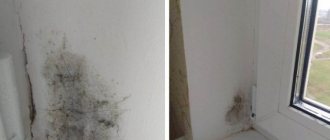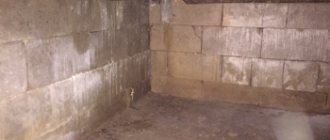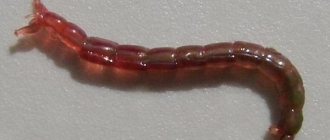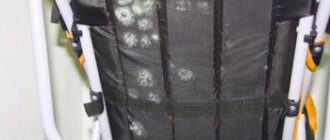A person spends about a third of his life in bed, and it is very important that the bed, mattress, and bedding are of high quality, comfortable and clean.
Mold on a mattress is very dangerous, since many fungal spores enter the human body during sleep. And this is fraught with the development of quite serious diseases and exacerbation of chronic ones. We recommend reading: “Mold Allergy.”
You can get rid of the fungus yourself (here are some tips below) or use dry cleaning services.
Is it possible to remove mold from a mattress?
Unlikely because:
- due to its size and weight, the mattress cannot be washed and dried normally at home (and going to dry cleaners is expensive: both the service itself and the delivery of the mattress back and forth will be expensive);
- Due to the large thickness of the filler, it is unlikely that it will be possible to remove mold spores from everywhere even with the most thorough cleaning.
Therefore, we immediately present the only really working advice: if mold has already appeared in the mattress, just buy a new one.
Useless ways
On the Internet you can find a bunch of useless advice that supposedly will help get rid of the problem. These are various folk methods (such as wiping the mattress with vinegar or sprinkling soda) and specialized chemistry (various mold repellents).
At home, they are useless and even dangerous because:
- They can only clean stains on the outer surface of the mattress (on the covering), but they simply cannot reach the inside of the filling (and there are mold spores there too);
- moisture (if these are some kind of solutions with water) can only aggravate the problem, plus it can cause the springs to rust (if there are any inside) or fungus to appear on the wooden frame;
- Some means can damage the filler.
Safety precautions for chemical processing
Due to the use of chemicals to remove insects, the following safety precautions must be followed:
- Always wear rubber gloves and a gauze bandage before starting treatment.
- Work in closed clothes. Be sure to cover your head with a thick scarf or other headdress.
- After completing the treatment, be sure to wash your hands and face well with soap, change clothes and go outside for several hours so that the drug has time to take effect.
- Ventilate the room.
Ways to fight
If you don’t want to buy a new mattress, and there isn’t a lot of mold on it, you can still try to remove it.
Important
: None of the methods will work if the cause of the mold is not eliminated. For example, if you take your mattress to the dry cleaner, but leave the bed near a cold, damp corner, the mold will return after some time.
Sun drying
The cheapest way, relevant in the summer, is to simply remove the mattress and take it out into the sun to dry on both sides.
Ideally, you should also knock it out thoroughly. It’s not worth knocking out a mattress on the balcony, or especially in the room: mold spores (or even just dust) will scatter around. Therefore, we take it out into the yard, put on a respirator, and get started.
Vacuuming
If the mattress is thin and/or double-sided, and if you have a powerful vacuum cleaner, this may help. We simply turn on the equipment to maximum mode and go over the entire area of the mattress on both sides and along all sides.
If your mattress is one-sided and thick, you can also try.
Professional cleaning (+video)
There are 2 options:
| Way | Cleaning at home | Cleaning with removal of the mattress to the cleaning company’s workshop |
| Description | The mattress is cleaned with an extractor vacuum cleaner (more powerful than a regular home vacuum cleaner). | The full complex looks like this: treatment with special means, cleaning with an extractor vacuum cleaner and drying |
| Price | Up to 2-3 thousand rubles (for 160x200, on both sides) | From 4-5 thousand (for 160x200 cm), on average for a full complex - 6-8 thousand, plus they may additionally charge for transportation if the mattress is single-sided on a frame |
| How long does it take | Few hours | Several business days (usually 2-4) |
The home cleaning process itself looks something like this:
How to get rid of it: the best recipes and remedies
Inhaling mold spores while sleeping is dangerous. This is fraught with the development of asthma, bronchitis, and skin diseases. Stages of self-decontamination:
- Assess the condition of the product and the degree of contamination.
- Manual surface treatment with a damp, hard sponge and disinfectant solution.
- Place the mattress in direct sunlight to dry and ventilate. This should be done for several days in a row.
The process of getting rid of mold is labor intensive. If owners are not ready for this, it is better for them to seek help from professionals. Featherbeds and mattresses are accepted for dry cleaning.
Using chemicals
Only household chemicals will help remove severe stains. During the procedures, you should wear a respirator and remove animals and children from the room. If possible, cleaning should be done in the air.
The best ways to remove mold from a mattress using household chemicals:
- 1 cap of white per liter of water. Treat black stains with a clean sponge.
- Ready-made sprays “Fonglifluid”, “Abedis” and “Mellerud” will cope with any organic growths, fungus, and mold. Do not harm the color of the coating. Not recommended for use in low temperature rooms.
- Liquid chemical compositions: “Olympus Stop-mold”, “Mavix-Bio”. Dilute with water according to the instructions, pour into a spray bottle.
- "Belinka". A broad-spectrum drug intended for the prevention and elimination of mold in rooms with high humidity. Safe for humans. Apply to the infected area with a brush or spray. Dries in 12 hours. Contains no bleaching ingredients and is not effective in removing color stains.
- Universal antiseptic "Dali". Also copes with algae and mosses. Does not contain volatile toxic compounds.
After treatment, the contaminated area should be completely dry. Then you need to go through the fabric with a vacuum cleaner at full power. It is not recommended to use items treated with chemicals before 3-4 days.
Important! When using anti-mold agents, you should work in a respirator and thick rubber gloves.
Using folk remedies
The fungus forms not only on food, but also on bathroom tiles and furniture. Folk recipes will help you find out what to do with mold on a mattress and how to eliminate detected contaminants:
- Sprinkle the affected surface with soda and sodium bicarbonate and leave it like that for 3 days. This will help absorb the unpleasant musty smell.
- Finely chop young branches of coniferous trees and place them in the space between the mattress and the bed. It is acceptable to use bags of herbs and spices.
- A mixture of vinegar, lemon juice and baking soda is applied to the stain for an hour. Afterwards you need to dry the treated area thoroughly.
- Leave the 3% hydrogen peroxide solution for 35 minutes. Wash off with warm water and laundry soap.
- Dilute ammonia with water 1 to 1. Treat stains with a moistened cloth and leave until they dry naturally. Remove residues with diluted washing powder with bleaching effect.
- A spoonful of ammonia and 2 tbsp. bring salt to a boil. Rub into affected tissue. Machine wash using anti-mold detergent.
- 1 tsp Dilute soda in a liter of hot water and spray generously on the affected area. Leave until dry, then rinse with clean water.
- Sprinkle the mattress generously with dry baking soda powder and leave for 3 hours. Vacuum thoroughly afterwards.
- Pour a thick layer of crushed chalk. Cover with a sheet of clean paper and iron the top with a hot iron. Remove residues with a stiff brush.
- Onion juice will help remove small stains. After cutting the onion in half, you need to rub the mattress pad. After 15 minutes, rinse with warm water and a sponge.
Note! Do not spray eau de toilette or alcohol-based deodorant onto a fungus-affected surface. Not only will this not help remove the musty smell, but it will also create dirty stains on the fabric.
Causes of mold on a mattress
Mold usually appears due to:
- dampness in the room, especially if it is a corner in which the bed is placed (for example, if the room is corner and the wall is not insulated);
- lack of ventilation;
- mold in other places close to the mattress (for example, on the wall, on bed linen, on curtains);
- liquid spilled on the mattress (however, due to 1 time and a small amount, mold may not appear).
Adviсe
Preventing mold from appearing on your bed is easier than fighting it. To do this, follow several rules for caring for bedding:
- Use mattress protectors. They prevent the mattress from quickly becoming dirty.
- Regularly air the mattress (turn it over) and the bedroom.
- Dry in fresh air.
If mold lesions are too extensive or fungal colonies have penetrated deep into the thickness of the bed, then it is better to replace the mattress with a new, high-quality and clean one.
Prevention
To prevent mold from appearing on the mattress:
- Place a topper on top of the “main” mattress.
- If possible, avoid placing your bed next to a cold, damp wall.
- If there is a storage space under the mattress, do not put dirty or wet things there, and open it periodically (at least once a month) for inspection and airing.
- If there is storage space under the mattress, it should not be tightly closed (and most beds are like that). As an option, drill holes in the walls in inconspicuous places (for example, in the back) so that air can enter and exit through them into the storage compartments and does not stagnate there.
- Air both bedding and mattress after sleep. Especially if you sweat profusely while sleeping, do not make the bed immediately after getting up: either change the bedding every time, or leave it open and/or shake out the wet areas until they dry.
- Avoid excessive humidity in the room.
- Place a waterproof mattress pad over the mattress. There are these, for example, in Ikea, for about 1,500 rubles for a double mattress 160x200 cm.
If there is no topper and/or mattress pad, take additional precautions:
- Do not eat or drink anything on the bed to avoid spilling anything.
- Do not put wet things on the bed (for example, a blanket under which you sweat a lot at night), and do not go there wet (for example, with wet hair after a shower).
Also, do not forget to react in time to the appearance of an odor. If you notice that your bed smells like mold, take action immediately.
How to get rid of mold in the basement, and how to prevent it from appearing?
Why does fungus appear in the bathhouse, and how to eliminate it: a list of methods
Related Posts
Foreign odor depending on the type of filler
Some materials used as fillers may have their own (“natural”) odors. The presence of such an odor does not necessarily mean that the product is of poor quality.
Latex
Natural latex exudes a subtle and even sweetish aroma of powdered milk or baked goods. It is noteworthy that not all people can smell this aroma.
Coconut coir
The likelihood of odor from coconut fiber greatly depends on the production technology. Completely dried, pressed (needle-punched) or latexed (latex-impregnated fiber) coconut simply cannot emit an unpleasant odor. The maximum is subtle (and soon disappearing) woody.
Foam rubber
Today there are a huge number of variations of products made from polyurethane foam and so-called memory foams. All of them are produced using the technology of foaming chemical components and petrochemical products (in compliance with global standards). As a result, there is a characteristic (non-caustic) “chemical” smell from the vapors accumulated while in the production packaging, which disappears forever after airing.
Mattress covering material
We should not forget about the covering fabric. New fabric may have a characteristic odor, which also disappears as a result of airing.
Additional Resources
- Mold and dampness. Centers for Disease Control and Prevention. https://www.cdc.gov/mold/dampness_facts.htm Accessed April 18, 2022.
- Shiue, I. Indoor mold odor in older homes was associated with allergic symptoms in adults, asthma, chronic bronchitis, vision, sleep, and self-rated health: USA NHANES, 2005–2006. Environ Sci Pollut Res. https://www.knowthecause.com/downloads/Shiue2015MoldOdorSleepComplaints.pdf Accessed April 18, 2022
- Janson S., Norback D. et al. Insomnia is more common in people living in damp buildings. Occupational and environmental medicine. https://oem.bmj.com/content/62/2/113 Accessed April 18, 2022
- Tiesler C, Thiering E, et al. Exposure to visible mold or dampness in the home and sleep problems in children: Findings from the LISAplus study. Ecological research. https://www.sciencedirect.com/science/article/pii/S0013935114004605 Accessed April 18, 2022.
Psst...the sleep review industry is full of liars, sharks and thieves. It's the modern version of getting ripped off at your local mattress store. So why should you trust us?
Are you sure you have bedbugs?
It is important to determine whether what is biting you is really bedbugs or not. Why is this so important? Different insects require different methods of removing parasites. We will not consider insects such as lice or fleas here, although of course these bloodsuckers also harm humans and require elimination, but these are completely different procedures.
In the initial stages of bedbug infestation in a residential area, it is difficult to notice the parasites with the naked eye. The bug is a cunning bloodsucker, unlike other parasites, it knows how to hide well, trying not to catch the eye. A night hunter, that’s what you can say about this insect, although with large infestations, hungry bugs attack during the day. This is the main problem in detecting bedbugs in the first stages of infestation of an apartment or house with bedbugs, attacking a person at night, and hiding as soon as the sun begins to rise.
1 - Sign
First of all, traces from bedbugs, as a rule, are bites, scarlet in color on open parts of the body, arms, and neck, shoulders, severe itching. Although these are general characteristics, they still have distinctive characteristics. Bedbug bites, as a rule, are lined up in one row, and not over the entire area of an open area of the body.
2 - Sign
If you wake up in the morning and find red or dark spots on your bed, this is a sign that they were around you. Red spots are blood; the origin of black spots may include several features:
• Shed bedbug skins











